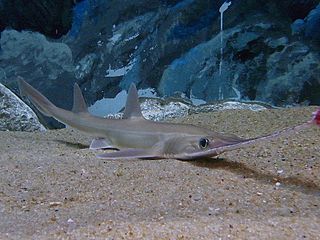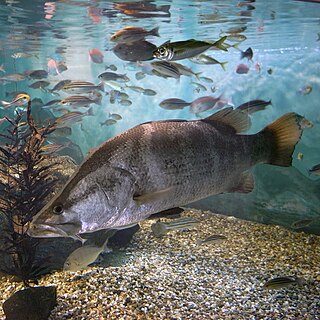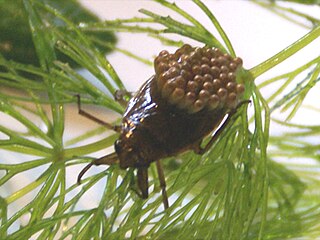
The Japanese sea lion was an aquatic mammal that became extinct in the 1970s. It was considered to be a subspecies of the related California sea lion until 2003. They inhabited the western North Pacific and its marginal seas including the Sea of Okhotsk and the Sea of Japan, especially around the coastal areas of the Japanese Archipelago and the Korean Peninsula. They generally bred on sandy beaches which were open and flat, but sometimes in rocky areas. They were hunted commercially in the 1900s, leading to their extinction.

The Cryptobranchidae are a family of large salamanders that are fully aquatic. The family includes some of the largest living amphibians. They are native to China, Japan, and the eastern United States. Giant salamanders constitute one of two living families—the other being the Asiatic salamanders belonging to the family Hynobiidae—within the Cryptobranchoidea, one of two main divisions of living salamanders.

The warbling white-eye is a small passerine bird in the white-eye family. The specific epithet is occasionally written japonica, but this is incorrect due to the gender of the genus. Its native range includes much of East Asia, including the Russian Far East, Japan, Indonesia, Korea, and the Philippines. It has been intentionally introduced to other parts of the world as a pet and as pest control, with mixed results. As one of the native species of the Japanese islands, it has been depicted in Japanese art on numerous occasions, and historically was kept as a cage bird.

The Japanese giant salamander is a species of fully aquatic giant salamander endemic to Japan, occurring across the western portion of the main island of Honshu, with smaller populations present on Shikoku and in northern Kyushu. With a length of up to 5 feet (1.5 m), it is the third-largest salamander in the world, only being surpassed by the very similar and closely related Chinese giant salamander and the South China giant salamander.

The Japanese sawshark is a species of sawshark in the family Pristiophoridae. This shark has a long, narrow rostrum. Its first dorsal fin originates behind the tips of the pectoral fins, and its caudal fin is angled almost straight in line with the body. The Japanese sawshark reaches a maximum length of up to 1.36 m.

The Japanese roughshark is a rare species of shark in the family Oxynotidae, known only from a handful of specimens recovered from Suruga Bay and the Enshunada Sea off Japan. It is a benthic species that occurs at a depth of 150–350 m (490–1,150 ft). This shark is caught as bycatch by bottom trawlers throughout its entire limited range, and may be threatened given the declines in other bottom deep sea species in Suruga Bay.

Euonymus fortunei, the spindle, Fortune's spindle, winter creeper or wintercreeper, is a species of flowering plant in the family Celastraceae, native to east Asia, including China, Korea, the Philippines and Japan. E. fortunei is highly invasive and damaging in the United States, causing the death of trees and forest in urban areas.

Parribacus japonicus, the Japanese mitten lobster, is a species of slipper lobster. Though the common name for this lobster is the Japanese mitten lobster, it is locally called zōri-ebi (ゾウリエビ) – zōri denoting the Japanese sandal it resembles, and ebi meaning shrimp or lobster.

The Japanese lates, also known as the akame or Japanese barramundi, is a species of fish found in Japan. A bottom-dweller restricted to estuarine habitats and large rivers in the Pacific coastal western parts of the country, it is threatened by habitat destruction. As it is similar to the related barramundi, it was classified as the same species until 1984.
Curelius japonicus is a species of silken fungus beetle in the family Cryptophagidae. It is found in North America.
Curelius is a genus of silken fungus beetles in the family Cryptophagidae. There are at least two described species in Curelius.

Derodontus is a genus of tooth-necked fungus beetles in the family Derodontidae. There are about eleven described species in Derodontus.

Neophylax is a genus of autumn mottled sedges in the family Uenoidae. There are more than 30 described species in Neophylax.

Armadilloniscus is a genus of woodlice in the family Detonidae. There are more than 30 described species in Armadilloniscus.

Stimulopalpus is a genus of tropical barklice in the family Amphientomidae. There are at least 30 described species in Stimulopalpus.
Nicagus is a genus of stag beetles in the family Lucanidae. There are at least three described species in Nicagus.

Eurypogon is a genus of soft-bodied plant beetles in the family Artematopodidae. There are about 11 described species in Eurypogon.

Dinoderus japonicus, the Japanese shot-hole borer, is a species of horned powder-post beetle in the family Bostrichidae. It is found in Australia, Europe and Northern Asia, North America, and Southern Asia.

Telmatogeton japonicus is a species of midge in the family Chironomidae. It is native to Japan and introduced to North America and Europe.

Appasus japonicus is a species of giant water bug in the family Belostomatidae. It is found in Japan and Korea, and has been much studied because it provides an example, rare among insects, of paternal care of the young. With the destruction of its typical habitat and its poor dispersal abilities, it has been listed as being an endangered species in Japan.

















